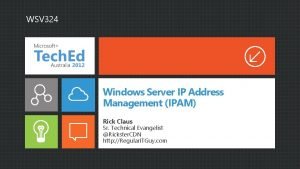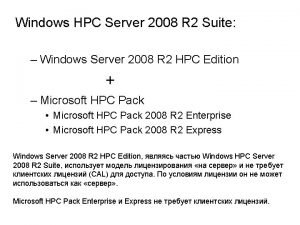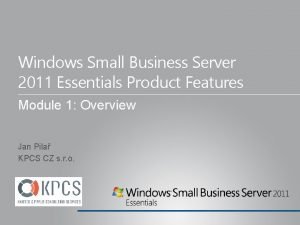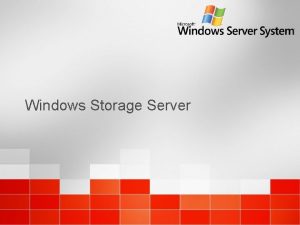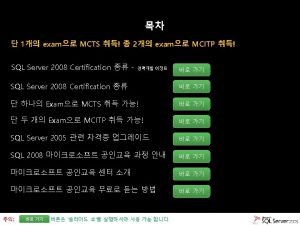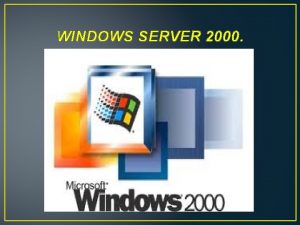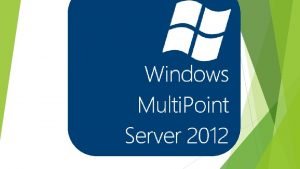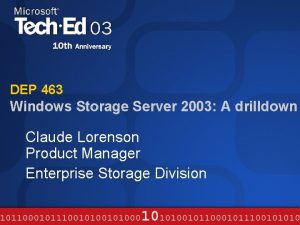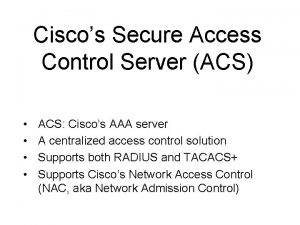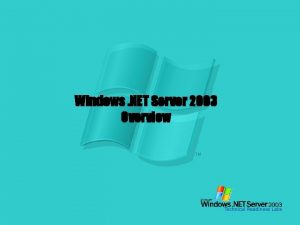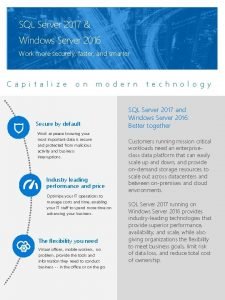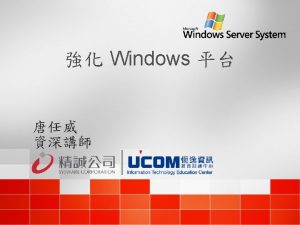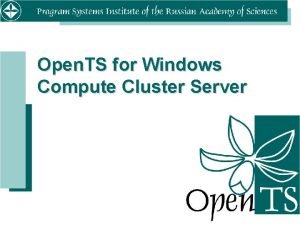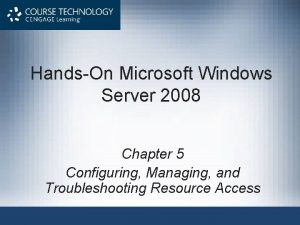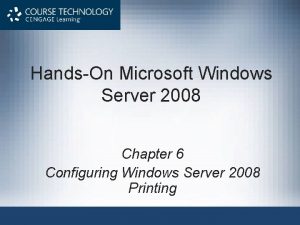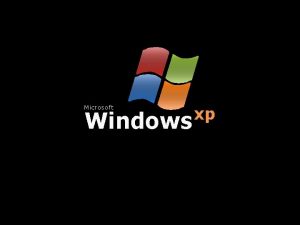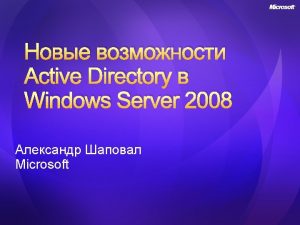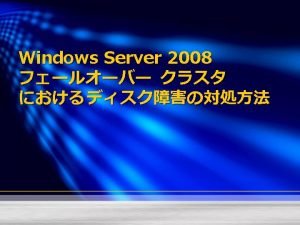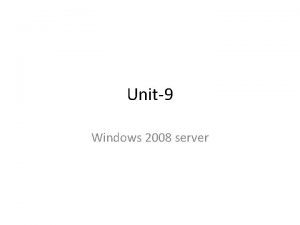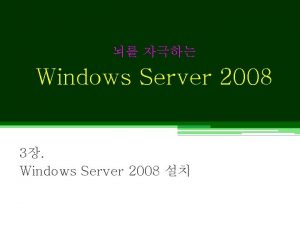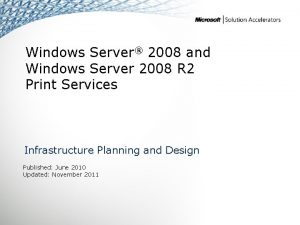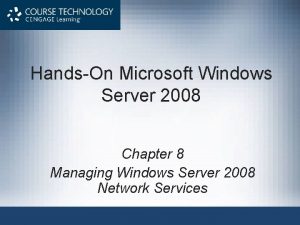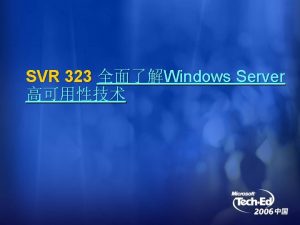HandsOn Microsoft Windows Server 2008 Chapter 5 Configuring








































- Slides: 40

Hands-On Microsoft Windows Server 2008 Chapter 5 Configuring Windows Server 2008 Printing

Objectives • Understand how Windows Server 2008 printing works • Use the XPS Print Path • Use the XML Paper Specification (XPS) • Install the Print Services role • Use the Printers window to configure printing properties Hands-On Microsoft Windows Server 2008 -Edited by: Maysoon Al-Duwais 2

Objectives (continued) • • • Install local and shared printers Configure printer properties Configure a nonlocal or Internet printer Manage print jobs Use the Print Management tool Hands-On Microsoft Windows Server 2008 -Edited by: Maysoon Al-Duwais 3

An Overview of Windows Server 2008 Printing • When a client decides to print a file he can do the printing either on: – Printer locally connected to the client’s computer (a local print device) – Or shared network printer (a network print device) – Or Internet printing (a type of network print device). Hands-On Microsoft Windows Server 2008 -Edited by: Maysoon Al-Duwais 4

An Overview of Windows Server 2008 Printing • Network printing process components 1) Local print device: A printer that is directly attached to a client computer (this printer is not shared in a network). 2) Network print device: A shared printer in the network. 3) Print client: The client computer who want to print a document. 4) Print server (The Network Print Server): The Windows Server 2008 server computer in the network who has a network print device (shared printer) attached to it. 5) Print job: The file to be printed. 6) Printer driver: the printer software (printer driver) that holds configuration information for the printer, it resides on the computer offering the printer services Hands-On Microsoft Windows Server 2008 -Edited by: Maysoon Al-Duwais 5

Network printing process components 2 Print Job 1 Network Print Job 2 Print client 1 Print Server (Windows Server 2008) 1 3 Local print device Print Job 1 Network print device Hands-On Microsoft Windows Server 2008 -Edited by: Maysoon Al-Duwais 6

How Network Printing Works • From slide 6, if the client wants to print a file (Print Job 1) using the network printer device the steps are as follows: • Printing process steps: 1) The client computer generates a print file (Print Job 1). 2) The application program (example: Microsoft word) in the client computer contacts Windows Graphics device Interface (GDI) to gather format information of the print file (example: font size, font color) 3) The client sends (Print Job 1) to the Server Service in the Print Server (Windows Server 2008) 4) The Print Server uses four processes to receive and process the print file (Print Job 1): router, print provider, print processor, and print monitor Hands-On Microsoft Windows Server 2008 -Edited by: Maysoon Al-Duwais 7

How Network Printing Works (continued) • Printing process steps (continued) 5) The Server service in the Print Server sends the print file (Print Job 1) to its router. 6) The router directs the print file (Print Job 1) to the print provider, which stores it in a spool memory until it can be sent to the printer. • Spooling a file means storing the file temporarily in a spool memory until the printer is ready to print it. 7) The print provider works with the print processor to ensure that the file is formatted to use the right data type 8) When the printer is ready, The print monitor takes the file (Print Job 1) from the spool memory and sends it to the printer. Hands-On Microsoft Windows Server 2008 -Edited by: Maysoon Al-Duwais 8

How Internet Printing Works • Internet Information Services (IIS) must be installed and running in Windows Server 2008 – The client must connect to the Windows Server 2008 IIS using a Web browser • The print process on the client is nearly the same as for network printing with a couple of exceptions: – The Web Browser in the client computer sends the print file to the GDI. – The client sends the printing job to IIS using Internet Printing Protocol (IPP). Hands-On Microsoft Windows Server 2008 -Edited by: Maysoon Al-Duwais 9

Using the XPS Print Path • XML Paper Specification (XPS) – An advanced way of printing documents for multiple purposes, including viewing electronic pages and printing pages in a polished format. • XPS is a concept similar to using PDF files • Using XPS printing is similar to saving a file with XPS extension (example: slides 12 -14). Hands-On Microsoft Windows Server 2008 -Edited by: Maysoon Al-Duwais 10

Using the XPS Print Path (continued) • Some of XPS enhancements – Advanced color support for sophisticated color printers – Faster performance for print files generated by. NET Framework applications Hands-On Microsoft Windows Server 2008 -Edited by: Maysoon Al-Duwais 11

Example of XPS printing 1 of 3 Hands-On Microsoft Windows Server 2008 -Edited by: Maysoon Al-Duwais 12

Example of XPS printing 2 of 3 Hands-On Microsoft Windows Server 2008 -Edited by: Maysoon Al-Duwais 13

Example of XPS printing 3 of 3 Hands-On Microsoft Windows Server 2008 -Edited by: Maysoon Al-Duwais 14

Installing the Print Services Role • Print Services role – Enables you to use the Print Management tool to manage shared printers – Also enables you to track printing events through a log you can view using the Event Viewer • Services within the role: – Print Server – Internet Printing – LPD Service Hands-On Microsoft Windows Server 2008 -Edited by: Maysoon Al-Duwais 15

Using the Printers Window • Windows Server 2008 Printers window is enhanced from previous versions to enable more flexibility Hands-On Microsoft Windows Server 2008 -Edited by: Maysoon Al-Duwais 16

Installing Local and Shared Printers • In Windows Server 2008, you can configure a printer that is attached to the server computer as a local printer – And then enable it as a shared printer • When you share a printer, the Windows Server 2008 server becomes a true print server Hands-On Microsoft Windows Server 2008 -Edited by: Maysoon Al-Duwais 17

Hands-On Microsoft Windows Server 2008 -Edited by: Maysoon Al-Duwais 18

Installing a Printer • If you are installing a Plug and Play compatible printer – Windows Server 2008 will automatically detect and install the new hardware • If the printer is not automatically detected, you can use the Add Printer Wizard to install it – Printers that are added using the Add Printer Wizard are shared by default Hands-On Microsoft Windows Server 2008 -Edited by: Maysoon Al-Duwais 19

Enabling Printer Sharing on a Network • After you install a printer on a network to be shared, turn on network printer sharing – This step enables printer sharing through the Windows Firewall Hands-On Microsoft Windows Server 2008 -Edited by: Maysoon Al-Duwais 20

Configure Printer Properties • Printer properties are available by opening Control Panel, then clicking Printer in the Control Panel Home View – Or the Printers applet in the Classic View to access the Printers window Hands-On Microsoft Windows Server 2008 -Edited by: Maysoon Al-Duwais 21

General Printer Specifications Hands-On Microsoft Windows Server 2008 -Edited by: Maysoon Al-Duwais 22

Sharing Printers • The Sharing tab is used to enable or disable a printer for sharing – As well as to specify the name of the share • If you enable sharing, provide a name for the shared printer – And check List in the directory to publish the printer through Active Directory so users can find it. Hands-On Microsoft Windows Server 2008 -Edited by: Maysoon Al-Duwais 23

Hands-On Microsoft Windows Server 2008 -Edited by: Maysoon Al-Duwais 24

Port Specifications • The Ports tab has an option to specify which server port, such as LPT 1, is used for the printer Hands-On Microsoft Windows Server 2008 -Edited by: Maysoon Al-Duwais 25

Port Specifications (continued) • Printer pooling – Involves configuring two or more identical printers connected to one print server. – Printer pooling requires that printers must be identical so that they use the same printer driver and handle print files in the same way • The Add Port button enables you to add a new port • The Delete Port button is used to remove a port option from the list of ports Hands-On Microsoft Windows Server 2008 -Edited by: Maysoon Al-Duwais 26

Port Specifications (continued) Hands-On Microsoft Windows Server 2008 -Edited by: Maysoon Al-Duwais 27

Configuring Security • To configure security for a printer, you must have Manage printers permissions for that printer – Use the Security tab to set up printer share permissions • Use the Advanced button on the Security tab to: – Set up special printer permissions for a specific group or user – Add or remove a group or user for security access – Set up printer auditing – Take ownership of a printer – View the effective permissions for a user or group Hands-On Microsoft Windows Server 2008 -Edited by: Maysoon Al-Duwais 28

Hands-On Microsoft Windows Server 2008 -Edited by: Maysoon Al-Duwais 29

Configuring Security (continued) Hands-On Microsoft Windows Server 2008 -Edited by: Maysoon Al-Duwais 30

Managing Print Jobs • Users with Print permissions can: – Send print jobs to the printer – Pause, resume, and restart their own print jobs – Cancel their own print jobs • Print Operators, Server Operators, and other groups having Manage documents permissions can: – Send print jobs to the printer – Pause, resume, and restart any user’s print jobs – Cancel any user’s print jobs Hands-On Microsoft Windows Server 2008 -Edited by: Maysoon Al-Duwais 31

Controlling the Status of Printing • In Windows Server 2008, printer control and setup information for a particular printer is associated with that printer’s properties • Sometimes you need to pause a printer to fix a problem • You can pause printing to that printer by opening the Printers window, double-clicking the printer, clicking the Printer menu – And clicking the Pause Printing option so there is a check mark beside it Hands-On Microsoft Windows Server 2008 -Edited by: Maysoon Al-Duwais 32

Controlling the Status of Printing (continued) Hands-On Microsoft Windows Server 2008 -Edited by: Maysoon Al-Duwais 33

Controlling Specific Print Jobs • You can pause, resume, restart, or view the properties of one or more documents – In the print queue of a printer • Print queue – A stack of print jobs, with the first job submitted at the top of the stack and the last job submitted at the bottom. Hands-On Microsoft Windows Server 2008 -Edited by: Maysoon Al-Duwais 34

Controlling Specific Print Jobs (continued) • In Windows Server 2008, to pause a print job, open the Printers window from Control Panel and doubleclick the appropriate printer • The resulting window shows a list of jobs to be printed – Click the document you want to pause, click the Document menu, and then click Pause • Jobs print in the order they are received, unless the administrator changes their priority Hands-On Microsoft Windows Server 2008 -Edited by: Maysoon Al-Duwais 35

Hands-On Microsoft Windows Server 2008 -Edited by: Maysoon Al-Duwais 36

Using the Print Management Tool • The Print Management tool – Also called the Print Management Console or PMC – Centralizes shared printer control in one place • Enabling printer administrators and operators to manage the print functions of some or all of the shared printers on a network • Using the Print Management tool, you can: – Start the Network Printer Installation Wizard to set up network printers for sharing – View and manage installed printers – View and manage printer drivers for installed printers Hands-On Microsoft Windows Server 2008 -Edited by: Maysoon Al-Duwais 37

Hands-On Microsoft Windows Server 2008 -Edited by: Maysoon Al-Duwais 38

Using the Print Management Tool (continued) • Using the Print Management tool, you can: (continued) – Determine if any printers are not ready to print – Determine which printers have print jobs in the print queue – Manage which printers are associated with which printer ports – Pause and restart printing on a particular shared printer – Manage print jobs Hands-On Microsoft Windows Server 2008 -Edited by: Maysoon Al-Duwais 39

Using the Print Management Tool (continued) • Using the Print Management tool, you can: (continued) – Manage printer sharing – Manage from one place shared printers set up on Windows 2000, Windows Vista, Windows Server 2003, and Windows Server 2008 – Export preconfigured settings to a network printer using the Printer Migration Wizard Hands-On Microsoft Windows Server 2008 -Edited by: Maysoon Al-Duwais 40
 Ipam server 2008
Ipam server 2008 Windows hpc server 2016
Windows hpc server 2016 Sql server management studio express
Sql server management studio express Small business server 2010
Small business server 2010 Small business server 2011 end of life
Small business server 2011 end of life Microsoft windows storage server 2003
Microsoft windows storage server 2003 Microsoft windows movie maker
Microsoft windows movie maker Devlin c rizzo
Devlin c rizzo Overlay transport virtualization
Overlay transport virtualization Dansguardian squid
Dansguardian squid Configuring a network operating system
Configuring a network operating system Configure a network operating system
Configure a network operating system Packet tracer configuring multiarea ospfv2
Packet tracer configuring multiarea ospfv2 2008 2008
2008 2008 James handson
James handson Alsa routing
Alsa routing A handson
A handson James handson
James handson James handson
James handson A handson
A handson Handson activities
Handson activities Handson activities
Handson activities Handson session
Handson session Sql server 2008 certification
Sql server 2008 certification Sql server security best practices
Sql server security best practices Microsoft robotics studio
Microsoft robotics studio Windows small business server 2003
Windows small business server 2003 Windows server 2000 caracteristicas
Windows server 2000 caracteristicas Windows multipoint server 2012
Windows multipoint server 2012 Windows server migration tools
Windows server migration tools Windows storage server 2003
Windows storage server 2003 Cisco secure access control server for windows
Cisco secure access control server for windows Windows 7 codename
Windows 7 codename Networking with windows server 2016
Networking with windows server 2016 Windows net server family
Windows net server family Sql server 2017 windows 7
Sql server 2017 windows 7 Nouveauté windows server 2016
Nouveauté windows server 2016 Windows server 2012 r2 essentials
Windows server 2012 r2 essentials Dlna server windows 10
Dlna server windows 10 Windows 2003 sp
Windows 2003 sp Windows compute cluster
Windows compute cluster
